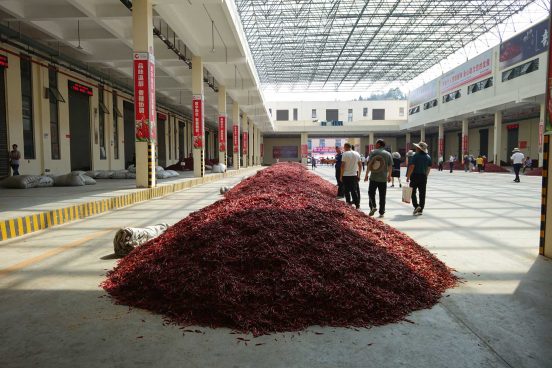China should be one of the great “hot spots” on the world map of the chilli. Chilli is everywhere in China… but it’s overlooked.
One just needs to have a look at the production data for the chilli to get an impression.

According to FAO numbers, China produces just over 50% of the world production of fresh chilli, more than 17 million tons a year.
It does not even account for 3% of the world exported quantity of fresh chilli, though.
What chilli China produces fresh, Chinese predominantly seem to eat!

World Spicy Kitchens
Ask someone what they think the world’s spicy kitchens are, and they are unlikely to answer Chinese.
People who are in the know will find that crazy. Sichuan’s capital Chengdu became a UNESCO “creative city” of gastronomy (as the first city in China). Sichuan is surely known for its hot and spicy cuisine. But not always.

Hunan food had been all the craze in the USA decades ago, surely it must be known? Maybe not.
“Regional Chinese food: 8 lesser-known cuisines worth trying“, published rather recently on CNN.com, does not exactly make it sound as if Hunan food were well recognized.
Hunan kitchen (xiang cai), renowned (in China) for its clear pungency, is one of China’s eight great culinary traditions, though.
CNN’s take:
While Sichuan’s numbing, spicy cuisine is popular around the world, the real spice capital of China — Hunan province — is still comparatively undiscovered.
https://edition.cnn.com/travel/article/regional-chinese-food/index.html
Strange, that.
But surely, Laoganma?
Laoganma, and especially its chilli crisp, has its aficionados and even its Facebook “Laoganma Appreciation Society“.
Compared to Sriracha, though, it’s still a relative unknown.
Don’t even try asking what else people know about Guizhou… if they even know that this is a Chinese province, and one where Laoganma comes from. And where China’s chilli capital, Zunyi, lies.
Chilli in China
Admittedly, the Chinese approach to chilli has not been helping.
Sometimes, chilli and spicy dishes and products are marketed pretty well.
Chilli is such a normal part of so many people’s everyday diet, and so normal in some dishes even of others, that it is usually overlooked.
There may be some heirloom(-like) varieties, but then they are just what is being grown and used locally. Variations are not usually too large; the awareness of anything like traditional varieties certainly isn’t (except in those cases where marketing has found their value).
Thus, some types of chilli are recognized, but things have not usually been going much deeper.

Modernization in Chilli
The drive towards modernization has been rather stronger and leading toward standardization.
In the market, that has its value – but so do the complementary considerations of the local and heirloom. With initiatives towards rural revitalization, these may also be going somewhere.
“Taobao villages” have found value in their local produce as a marketing mechanism, and China has a tradition of prizing the produce of different areas.
In Sichuan pepper, for example, one finds two places said to produce the very best of it; many that are differentiated by the aficionado. With many fruits and not a few famous dishes, this is also the case.
This tension between the traditional and the modern is hardly new. Where Europe and the USA have needed decades for both to be found of value, China is moving there in leaps and bounds. China may easily be the one country where William Gibson’s “The future is already here, it’s just not evenly distributed” absolutely applies.
Meanwhile, however it is developing and changing, the chilli is everywhere in China.
In much of the food. In fields. In pots along hutong alleyways. Even in good luck charms.
It is around so much, it gets overlooked.




Leave a Reply
You must be logged in to post a comment.